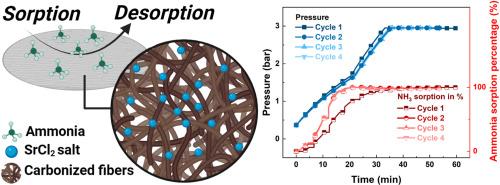Strontium chloride nanofiber composites for ammonia storage and delivery
IF 7.9
3区 材料科学
Q1 GREEN & SUSTAINABLE SCIENCE & TECHNOLOGY
引用次数: 0
Abstract
Solid-state ammonia storage supports the transition towards safe and efficient low-carbon energy storage and transportation. Alkaline earth metals halides (AEMHs) based materials, such as strontium chloride (SrCl2), can be utilized to efficiently store ammonia with high capacity and mitigate ammonia toxicity but suffer from large volume expansion during ammonia absorption and slow thermal desorption kinetics. Here, SrCl2 was structured into SrCl2-carbon nanofiber composites (SrCs) by electrospinning and a subsequent three-step carbonization process. Polyvinylpyrrolidone (PVP) was used as a carrier polymer in water/ethanol solution in electrospinning and as a carbon source for stabilizing SrCs with high SrCl2 loadings. Chemical and structural changes of the nanofiber structures during carbonization were investigated with different surface characterization techniques, including XRD, SEM, and FTIR. The SrCs could be loaded with up to 90 wt% of SrCl2 salt, resulting in remarkable high, and stable ammonia sorption uptake capacity of 671 mg/g over four cycles, mechanical integrity and more than 4 times faster desorption kinetics compared to SrCl2 powder.

用于氨储存和输送的氯化锶纳米纤维复合材料
固态氨储存支持向安全高效的低碳能源储存和运输过渡。碱土金属卤化物(AEMHs)基材料,如氯化锶(SrCl2),可以有效地储存高容量氨和减轻氨毒性,但在氨吸收过程中存在体积膨胀大和热解吸动力学慢的问题。在这里,SrCl2通过静电纺丝和随后的三步碳化工艺被构造成SrCl2-碳纳米纤维复合材料(src)。聚乙烯吡咯烷酮(PVP)作为静电纺丝水/乙醇溶液中的载体聚合物,并作为稳定高SrCl2负载src的碳源。采用XRD、SEM和FTIR等不同的表面表征技术,研究了碳化过程中纳米纤维结构的化学和结构变化。SrCl2可负载高达90%的SrCl2盐,在4个循环中具有671 mg/g的高稳定的氨吸附能力,机械完整性和比SrCl2粉末快4倍以上的脱附动力学。
本文章由计算机程序翻译,如有差异,请以英文原文为准。
求助全文
约1分钟内获得全文
求助全文
来源期刊

Materials Today Sustainability
Multiple-
CiteScore
5.80
自引率
6.40%
发文量
174
审稿时长
32 days
期刊介绍:
Materials Today Sustainability is a multi-disciplinary journal covering all aspects of sustainability through materials science.
With a rapidly increasing population with growing demands, materials science has emerged as a critical discipline toward protecting of the environment and ensuring the long term survival of future generations.
 求助内容:
求助内容: 应助结果提醒方式:
应助结果提醒方式:


